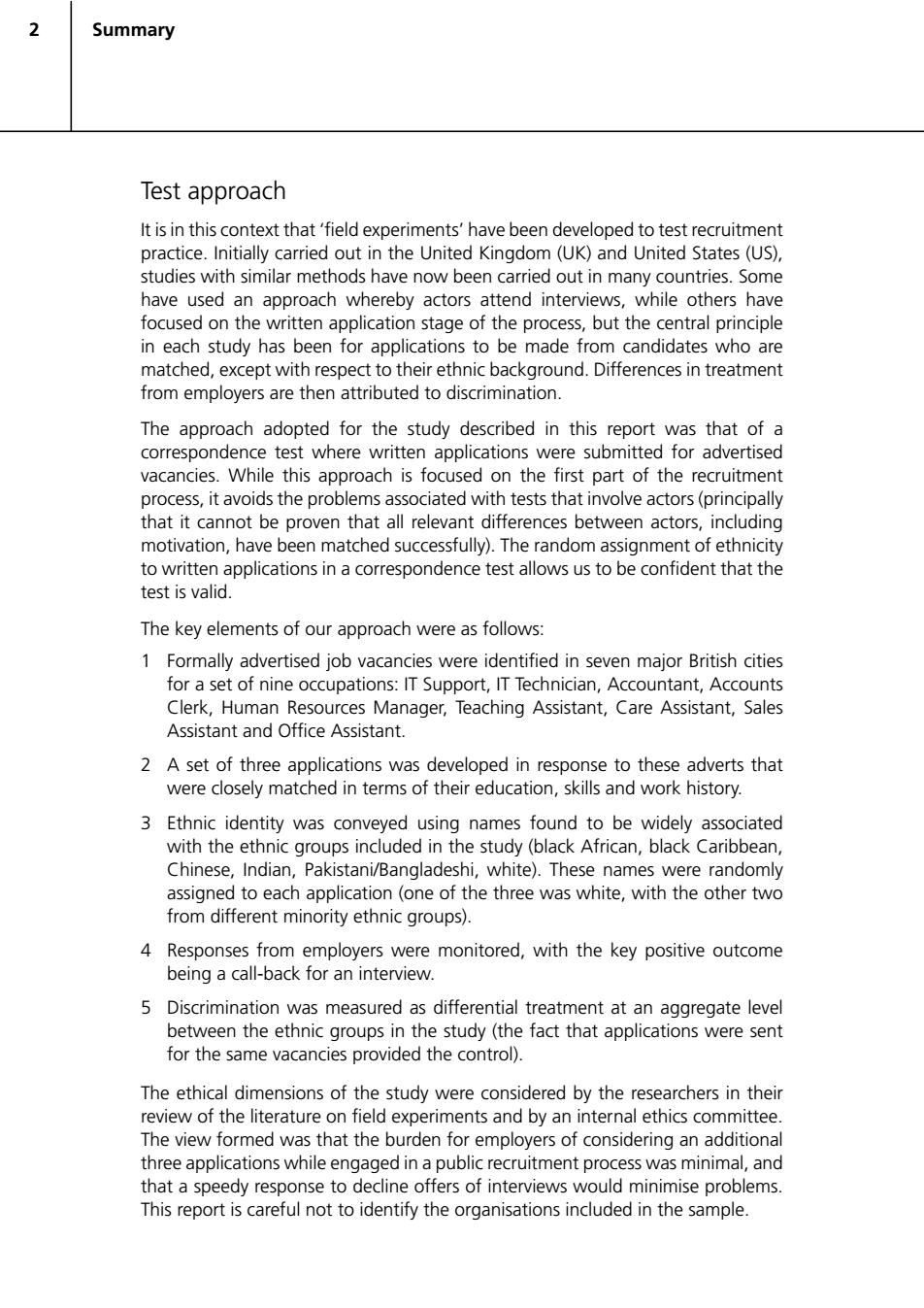正在加载图片...

2 Summary Test approach It is in this context that 'field experiments'have been developed to test recruitment practice.Initially carried out in the United Kingdom(UK)and United States(US), studies with similar methods have now been carried out in many countries.Some have used an approach whereby actors attend interviews,while others have focused on the written application stage of the process,but the central principle in each study has been for applications to be made from candidates who are matched,except with respect to their ethnic background.Differences in treatment from employers are then attributed to discrimination. The approach adopted for the study described in this report was that of a correspondence test where written applications were submitted for advertised vacancies.While this approach is focused on the first part of the recruitment process,it avoids the problems associated with tests that involve actors(principally that it cannot be proven that all relevant differences between actors,including motivation,have been matched successfully).The random assignment of ethnicity to written applications in a correspondence test allows us to be confident that the test is valid. The key elements of our approach were as follows: 1 Formally advertised job vacancies were identified in seven major British cities for a set of nine occupations:IT Support,IT Technician,Accountant,Accounts Clerk,Human Resources Manager,Teaching Assistant,Care Assistant,Sales Assistant and Office Assistant. 2 A set of three applications was developed in response to these adverts that were closely matched in terms of their education,skills and work history. 3 Ethnic identity was conveyed using names found to be widely associated with the ethnic groups included in the study (black African,black Caribbean, Chinese,Indian,Pakistani/Bangladeshi,white).These names were randomly assigned to each application (one of the three was white,with the other two from different minority ethnic groups). 4 Responses from employers were monitored,with the key positive outcome being a call-back for an interview. 5 Discrimination was measured as differential treatment at an aggregate level between the ethnic groups in the study(the fact that applications were sent for the same vacancies provided the control) The ethical dimensions of the study were considered by the researchers in their review of the literature on field experiments and by an internal ethics committee. The view formed was that the burden for employers of considering an additional three applications while engaged in a public recruitment process was minimal,and that a speedy response to decline offers of interviews would minimise problems. This report is careful not to identify the organisations included in the sample.2 Test approach It is in this context that ‘field experiments’ have been developed to test recruitment practice. Initially carried out in the United Kingdom (UK) and United States (US), studies with similar methods have now been carried out in many countries. Some have used an approach whereby actors attend interviews, while others have focused on the written application stage of the process, but the central principle in each study has been for applications to be made from candidates who are matched, except with respect to their ethnic background. Differences in treatment from employers are then attributed to discrimination. The approach adopted for the study described in this report was that of a correspondence test where written applications were submitted for advertised vacancies. While this approach is focused on the first part of the recruitment process, it avoids the problems associated with tests that involve actors (principally that it cannot be proven that all relevant differences between actors, including motivation, have been matched successfully). The random assignment of ethnicity to written applications in a correspondence test allows us to be confident that the test is valid. The key elements of our approach were as follows: 1 Formally advertised job vacancies were identified in seven major British cities for a set of nine occupations: IT Support, IT Technician, Accountant, Accounts Clerk, Human Resources Manager, Teaching Assistant, Care Assistant, Sales Assistant and Office Assistant. 2 A set of three applications was developed in response to these adverts that were closely matched in terms of their education, skills and work history. 3 Ethnic identity was conveyed using names found to be widely associated with the ethnic groups included in the study (black African, black Caribbean, Chinese, Indian, Pakistani/Bangladeshi, white). These names were randomly assigned to each application (one of the three was white, with the other two from different minority ethnic groups). 4 Responses from employers were monitored, with the key positive outcome being a call-back for an interview. 5 Discrimination was measured as differential treatment at an aggregate level between the ethnic groups in the study (the fact that applications were sent for the same vacancies provided the control). The ethical dimensions of the study were considered by the researchers in their review of the literature on field experiments and by an internal ethics committee. The view formed was that the burden for employers of considering an additional three applications while engaged in a public recruitment process was minimal, and that a speedy response to decline offers of interviews would minimise problems. This report is careful not to identify the organisations included in the sample. Summary